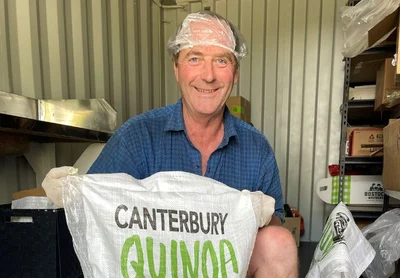Quinoa a growing success

A Methven farmer with a love for growing different seeds has developed a crop-to-kitchen business supplying quinoa to Canterbury homes and beyond.
Third-generation crop and seed farmer Andrew Currie embarked on his quinoa journey when he tried some ancient grains as rotation crops for his regular wheat, barley, and grass seed crops.
The first quinoa trial on Currie’s 300-hectare farm was 3kgs of supermarket-bought quinoa seed.
It grew well, but the yields were not good, he said.
He’s experimented with quinoa for the last 13 or so years, bringing in seeds with improved genetics, better yields, nuttier taste, and lower saponin.
Saponin is a naturally occurring outer coating that gives quinoa a bitter taste to deter birds. Quinoa with high saponin needs to be rinsed and washed before it is cooked. That is a process that’s not necessary with Currie’s lower-saponin quinoa.
Although quinoa is traditionally grown at high altitudes in the Andes, Currie finds it grows well but is hard to harvest.
He grows about 10 tonnes of quinoa each year and sells both seeds and flakes wholesale in 25kg bags and retails directly to New Zealand customers looking for locally-grown spray-free quinoa.
Fast forward to today and Currie has just spent “a fortune” to bring in seeds for a new variety of quinoa from Europe for next year’s crop. He’s hoping for better yields from the latest seeds.
He’s also got three different types of millet and chickpea seeds coming in.
“I love growing different stuff. It’s fun –and I’ve got an understanding bank manager.”
Experimenting with alternative crops is in Currie’s blood. His father was one of a few farmers to get into canary seed back in 1964.
Currie still grows canary seed along with Hungarian millet – another staple bird seed.
“Some years it (millet) grows really well and some years it fails really well. It’s been 37 years and I’m still learning how to grow it.”
Currie said he was still searching for viable break crops and found that a challenge.
He’s tried a wide range including grey-striped sunflowers and hemp. These grow well, but wild birds made them a “struggle”.
A number of seeds, like coriander and chia, don’t do well. While Canterbury gets warm days it cools at night and the total heat units were not enough for either crop, Currie said.
Borage, buckwheat and brassicas grow well but the viability of these crops varies from year to year depending on the price for each seed. At lower prices, it can pay for the cost of production but does not put food on the table.
Currie said it was a “learning curve” to go from quinoa farmer to supplying the public. He and his partner, Gaewynne Hood, had to learn about health and safety requirements, labelling laws and biodegradable packaging.
They sell white, golden and white quinoa as seeds, as well as quinoa flakes online.
“The flakes are more versatile than the seeds but we sell more seeds than flakes.”
Currie said the flakes could be used to replace dry ingredients in baking, thickening soups and as a porridge.
They have recipes online that range from garlic, zucchini and quinoa fritters to chocolate quinoa muffins and cakes.
Quinoa Fast Facts
Quinoa (pronounced keen-wah) is part of the amaranth family which includes beets, chard and spinach.
It was historically a vital part of the Andean diet, dating back to the Incas.
It is a nutrition-dense seed with high levels of protein, vitamins, minerals, and fibre to help you stay full for longer.
Quinoa has recently gained popularity as a superfood and is popular with vegans, vegetarians and people on a gluten-free diet.
By Sharon Davis

